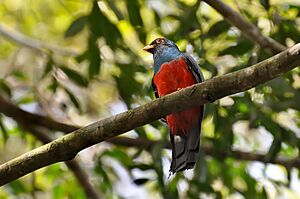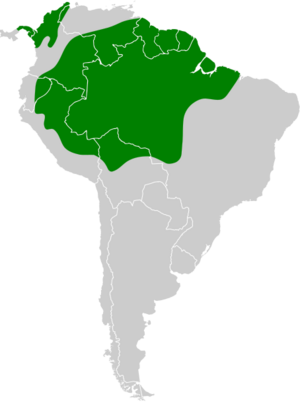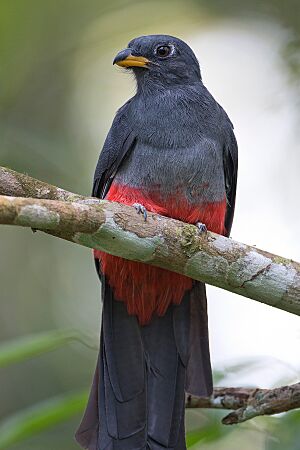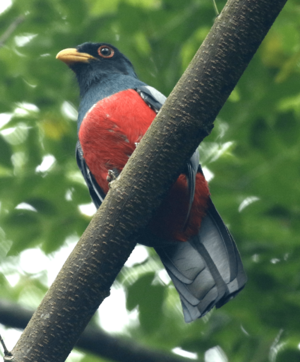Black-tailed trogon facts for kids
Quick facts for kids Black-tailed trogon |
|
|---|---|
 |
|
| Conservation status | |
| Scientific classification | |
| Genus: |
Trogon
|
| Species: |
melanurus
|
 |
|
The black-tailed trogon (Trogon melanurus) is a colorful bird that belongs to the trogon family. This family also includes the famous quetzals. You can find the black-tailed trogon in Panama and across northern parts of South America.
Contents
Understanding Black-tailed Trogons
What Are Subspecies?
Scientists group animals into species, and sometimes into smaller groups called subspecies. These groups are slightly different from each other, often because they live in different areas. The black-tailed trogon has a few subspecies. The main ones are T. m. melanurus, T. m. macroura, and T. m. eumorphus. Another subspecies, T. m. occidentalis, is also sometimes recognized.
How to Identify a Black-tailed Trogon
Black-tailed trogons are medium-sized birds, usually about 28 to 30 cm (11 to 12 in) long. They weigh between 52 to 122 g (1.8 to 4.3 oz).
Male Trogons
Male black-tailed trogons are very striking. They have a bright yellow beak. Their face and throat are blackish, with a cool orange-red ring around each eye. Their head, neck, back, and chest are a shiny green color. A white band separates their green chest from their bright red belly. Their tail feathers are deep blue on top and gray underneath. When their wings are folded, they look gray because of tiny, wavy lines.
Female Trogons
Female trogons look a bit different. Their upper beak is gray. Instead of green, their head, back, and chest are gray. The gray on their chest extends further down their belly. They don't have the orange-red eye ring; instead, they have white arcs around their eyes.
Subspecies Differences
Some subspecies have small differences. For example, the male T. m. macroura has longer wings and tail. Its wing patterns are also a bit rougher, and its upper tail is more turquoise. The male T. m. eumorphus has darker wings and a bluer tail than the main subspecies. Its white chest band is also narrower.
Where Black-tailed Trogons Live
Black-tailed trogons live in many different places across their large range.
Geographic Distribution
- T. m. macroura lives in Panama, east of the Canal Zone. It also lives in northern Colombia and a small part of northwestern Venezuela.
- The main subspecies, T. m. melanurus, is found from eastern Colombia through southern Venezuela and the Guianas. It also lives in northeastern Brazil.
- T. m. eumorphus lives south of melanurus. You can find it from southern Colombia through eastern Ecuador and Peru. It also extends into northern Bolivia and eastern Amazonian Brazil.
Preferred Habitats
These birds live in various types of forests. In Panama, they like humid lowland and foothill forests. This includes both old, untouched forests and newer, regrowing forests. In Venezuela and French Guiana, they live in rainforests. In the Amazonia region, they are found in many forest types. These include swamp forests, forests along rivers (called gallery forests), and forests on higher ground.
They can live at different elevations too. In Colombia, west of the Andes mountains, they can be found as high as 2,200 m (7,200 ft). East of the Andes, they usually stay below 500 m (1,600 ft). In Venezuela, north of the Orinoco River, they are found below 100 m (330 ft). South of the river, they can go up to 1,000 m (3,300 ft).
Black-tailed Trogon Behavior
Daily Movements
Most black-tailed trogons stay in the same area all year round. They don't migrate far. However, in Bolivia, some of them move between dry forests and lowland rainforests depending on the season.
What They Eat
Black-tailed trogons have a varied diet. They eat many different kinds of insects. They also enjoy fruits. Sometimes, they might even eat small amphibians like frogs or tiny reptiles. They often join groups of different bird species that are looking for food together in the treetops. They also search for food closer to the ground.
How They Raise Their Young
The breeding season for black-tailed trogons changes depending on where they live. It can be as early as March in Panama or as late as September and October in Peru. They build their nests inside holes. These holes are often found in termitaria (large nests built by termites) that are high up in trees. They might also nest in decayed trees, but this is less common. A female trogon usually lays two or three eggs.
Their Calls and Songs
The song of the black-tailed trogon sounds like "kwo-kwo-kwo..." They can sing a long series of up to 46 notes! They also make a soft, bubbly, purring sound.
Conservation Status
The IUCN (International Union for Conservation of Nature) has evaluated the black-tailed trogon. They have listed it as a species of "Least Concern." This means that the bird is not currently in danger of extinction. It lives across a very large area. Even though scientists haven't counted every single bird, they believe the population is stable. Generally, you can find black-tailed trogons quite commonly throughout their range.




